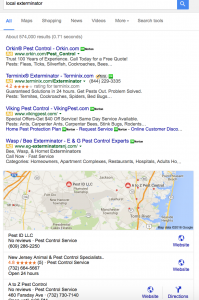
When to Call in the Pros: Lessons in Marketing DIY
My husband rallied some neighbors to help, and the amateur carpenter bee hunters gathered to strategize their attack. Meanwhile, a group of neighborhood kids assembled to place bets on which dad would fall off the roof first. Miraculously, no one was hurt during the mission (including most of the bees). The carpenter bee hunters heartily congratulated each other on a job well done and fired up the grill.
The next day, I noticed my husband sitting in his car in the driveway for an unusually long time. I followed his gaze to the roof, where the carpenter bees were back at work. I heard his voice from the car window, “What’s the number for the exterminator?”
What DIY Projects Can Teach Us About Marketing
What does this teach us about marketing, other than exterminators are missing big opportunities if they don’t plan direct mailings and paid search campaigns around carpenter bee swarms? The other valuable lesson is determining when to call in the pros.
Effective marketing doesn’t require a medical license or an advanced degree, so it’s often treated as a do-it-yourself project. Just as it takes extensive training and licensing to become a pest control professional, marketing is more than being a good communicator or knowing your products well.
How A Small Business Can Look Big
Selling or promoting a product or service requires experience and know-how in a variety of channels including digital advertising, websites, digital marketplaces, print marketing and direct mail, to list a few. Big companies, with teams of marketing professionals on staff and bigger ad budgets, obviously have an advantage over smaller competitors. Outsourcing some marketing projects to the right agency can help a small business look big on a much tighter budget.
An Informal Google Search Case Study
 To illustrate, think about how a local pest control company competes against a national brand. Based on what we know about how people look for information, most will search Google® or ask local friends – and many will ask for recommendations from friends on Facebook – all from a mobile device. Here is a screenshot of a Google search for “local exterminator.” As you can see, national brands with sizeable advertising budgets take up a good chunk of the first page. However, the local business that sets up “Google My Business” correctly visibly has a head start over other organic results.
To illustrate, think about how a local pest control company competes against a national brand. Based on what we know about how people look for information, most will search Google® or ask local friends – and many will ask for recommendations from friends on Facebook – all from a mobile device. Here is a screenshot of a Google search for “local exterminator.” As you can see, national brands with sizeable advertising budgets take up a good chunk of the first page. However, the local business that sets up “Google My Business” correctly visibly has a head start over other organic results.
Next, the pest control shopper will either call the local exterminator, or more than likely continue to research by checking out the website and reviews. Is the website professional looking? Does this look like a trustworthy business? Are there customer testimonials? Most importantly, is the contact information easy to find? Can an appointment be set up online? Is this company using retargeting ads on Facebook and other places to remind the shopper about this business?
Jumping ahead, the local exterminator gets the business, and the customer is happy. The exterminator gets permission to add this customer to the contact list. Now the exterminator can send an email next year to remind the customer that carpenter bees will soon be in his/her area and it’s time to schedule an appointment. The exterminator will also ask the customer to share a review on the website. This customer will more than likely respond to the original Facebook post, thanking all the friends for sharing recommendations and raving about this exterminator.
Allocating Resources and Time
This happy ending – or more accurately, happy beginning of a repeat customer, (plus the new customers this happy customer generates) sounds pretty easy. However, the small business local exterminator is very busy controlling pests and scheduling more appointments, leaving little time for marketing. Plus the exterminator knows a lot about chemistry and entomology, but isn’t as well-versed in digital advertising or email marketing. This is the time to call in the marketing pros.
Cajam Marketing helps lots of small businesses navigate the ever-evolving marketing channels including digital advertising, web services, marketplaces, content marketing and analytics. With over 24 years in the business, we know a lot about marketing – and not much about carpenter bees. Contact us and find out how we can help your business.

